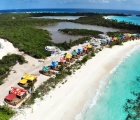(Eleuthera, Bahamas) While “Coastal Ecosystem Awareness” likely brings images of coral reef and white sand beaches to mind, most people are not likely to consider mangroves as a critical habitat in need of protection in The Bahamas. Mangroves are the only trees capable of surviving in saltwater, and to cope with this, some species (like those found locally) have developed tangled root systems. These mangrove forest’s intricate roots help protect the coastline and settlements from storm surges and erosion, and provide a protective nursery for juveniles of many fish species. Mangroves forests also provide feeding areas and daytime refuge for larger fish (and even sea turtles!) to avoid being eaten by predators, and at night, mangroves attract predatory fish such as mutton snapper and grunts. Of most importance to Bahamian fisheries, though, is that economically important species such as grouper, conch, lobster, snapper, and bonefish rely on mangrove forests for feeding or nursery grounds. Thus, healthy mangrove creeks are essential for sustaining healthy fisheries.

A mangrove system in South Eleuthera. This is important habitat for juvenile fish, as well as bigger animals such as rays and turtles.
As seen in the photo on the right, the roots of mangroves make perfect nurseries for young fish. Mangrove roots provide lots of food and shelter, and help fish avoid predation.
Mangrove creeks are important to more than bonefish and snapper. Studies have shown that mangroves, flats, sea grass, and coral reefs are all highly connected. Coral growth located near mangroves is often healthier than corals away from mangroves. Also, fish that migrate into mangrove systems, like bonefish, transport nutrients from sea grass and reefs into mangrove creeks, thus increasing health of the Bahamian mangroves. Because ALL of the Bahamas’ coastal habitat is highly connected, any damage or degradation to one habitat might negatively impact the entire coastal ecosystem.
Unfortunately, global destruction of mangrove habitat continues. The Bahamas National Coastal Awareness Committee has identified 5 main threats to our coasts: habitat destruction, climate change, pollution/marine debris, overfishing and invasive species. Approximately one-third of the world’s mangrove forests have been lost due to coastal development over the last 50 years. This number is even larger in the Bahamas, as 80-90% of Bahamian mangrove systems are affected by coastal development.

Cultivator pots & biodegradable planters made out of concrete mixed with compost – with mangroves prior to being transplanted in local creeks (right). Students from a visiting Educational Program conduct a Rapid Ecological Assessment (REA) in a South Eleuthera Creek (left).
Across the Bahamas and greater Caribbean area, historical development has resulted in the bulldozing and dredging of extensive mangrove systems, destroying the habitat of juvenile fish, conch and crawfish. Even small projects such as access roads can have significant impacts on the mangrove systems. Access roads with improper culverts (water passages) can alter the quality of the water on either side of the access road, sometimes making one side unsuitable for larval and juvenile fish development, and stopping the movement of bonefish, sharks, or turtles to essential feeding grounds.
In 1992 the Bahamian government signed the Convention on Biological Diversity, recognizing the importance of marine biodiversity and the necessity to develop mechanisms for the sustainable use of coastal and marine biological diversity. Since then, there has been an increased focus on coastal awareness and research in The Bahamas.
 The Cape Eleuthera Institute’s (CEI) Flats Ecology and Conservation Program is working with local schools, fishing guides, and local and international NGOs to raise awareness about coastal ecology, coastal destruction, and coastal rehabilitation in The Bahamas. One of the first steps taken by CEI and its partners was to assess the health of Eleuthera’s mangrove ecosystems. Despite the importance of mangroves, there was no historical data on the health of our local coastal habitats. This is done using a survey technique called ‘rapid ecological assessments’ or REAs. These surveys take note of the species present and their abundance in each creek, the quality of the water, and how humans are impacting these systems. This information allows us to compare creeks and determine the creek ‘health’, and see which creeks are important for different species. Researchers at CEI have recently expanded the assessments of mangrove health to areas in The Exumas, and will be performing assessments and outreach on Abaco in April.
The Cape Eleuthera Institute’s (CEI) Flats Ecology and Conservation Program is working with local schools, fishing guides, and local and international NGOs to raise awareness about coastal ecology, coastal destruction, and coastal rehabilitation in The Bahamas. One of the first steps taken by CEI and its partners was to assess the health of Eleuthera’s mangrove ecosystems. Despite the importance of mangroves, there was no historical data on the health of our local coastal habitats. This is done using a survey technique called ‘rapid ecological assessments’ or REAs. These surveys take note of the species present and their abundance in each creek, the quality of the water, and how humans are impacting these systems. This information allows us to compare creeks and determine the creek ‘health’, and see which creeks are important for different species. Researchers at CEI have recently expanded the assessments of mangrove health to areas in The Exumas, and will be performing assessments and outreach on Abaco in April.
After identifying 1) how humans are impacting mangrove habitats, 2) which mangrove creeks are most important for the production of fish on Eleuthera, and 3) which mangroves could best benefit from habitat rehabilitation, successful management and restoration practices can be implemented to ensure the longevity of Eleuthera’s fisheries. To accomplish this, CEI has developed methods for replanting mangrove seedlings and propagules with the use of cultivator pots, or bio-degradable planters. Propagules (floating mangrove seeds) are collected from local creeks, planted in cultivator pots, grown in CEI’s mangrove nursery, and then with the help of local schools, will be transplanted in local creeks.
If nothing is done to manage the effect of coastal development or other coastal threats, then we may start to see declines in our local fish population, including conch and crawfish. Therefore it is extremely important that we look after our mangroves to sustain local fish populations, so future generations can use them in years to come.
What can you do to help The Bahamas’ coastal habitats?
- Educate yourself and others of the importance of these systems. Contact CEI to include your local schools in research and mangrove rehabilitation efforts
- Let your local representative know how important mangroves are to you and your fisheries
- Celebrate Coastal Awareness Month by cleaning up trash from your beaches and mangrove creeks
For more information, please contact the manager of the Flats Ecology and Conservation Program at CEI, Zach Zuckerman; zachzuckerman@ceibahamas.org





